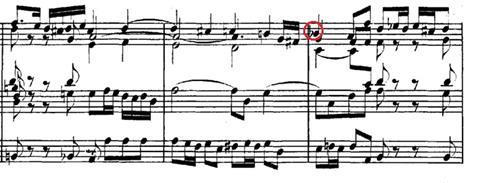Excessive reverence for Bach’s manuscript is leading violinists to make a mistake early in the first sonata, writes Hagai Shaham
Bach’s first violin solo sonata BWV 1001 is composed in a key of G minor yet it has only one flat in its key signature. This notation method was quite common at the time and was used by various composers (Torelli, Vivaldi, Bach and others). The exact reason for omitting one flat is open to discussion; whether or not it is a modal tonality (Dorian) or just a more convenient way of writing the notes, using less accidentals when modulating to the dominant key and further.
Usually, this would not affect our reading and there are seldom notes in question. However, in bar 3 of the Adagio, the flat symbol before the E (bass note of the chord) is missing.

Recently, several performers, who are aware of the ultimate source (Bach manuscript copy from 1720), started to perform and record the text as written, thus playing E natural, even though this note was played as E flat by previous generations (see all editions since Ferdinand David edition of 1843, Bach-Gesellschaft Ausgabe from 1879, ‘urtext’ editions like Baerenreiter).
The E natural creates an unusual disturbing harmony, which is very foreign to Bach’s harmonic language. Here are my reasons to believe the note should be an E flat:
1. The progression I – (VI 6 – V6) - IV6 – V is common in the style and logical (standard Phrygian cadence; see toccata and fugue in d minor). Although I goes through VI6 to V6, they serve as passing chords that connect the initial I to the more important IV6.

2. The parallel harmonic progression appears at the recap on the sub dominant key of C minor in bar 16. Here it is a clear A flat at the bass and not A natural.

3. The melodic line should sound acceptable when played together with the bass. It works well with E flat but sounds peculiar with E natural. The other E flat notes at the same bar create a shocking clash so early in the piece if harmonized with E natural.
4. If E natural is played, it sounds like it is ‘resolved’ to the relatively ‘pleasant’ E flat (circled bellow); but E flat is not a resolution, it is still a strong dissonance of a major 7th under the D, on its way to the dominant chord next bar.

5. If the short E flat (1/32th) would constitute a real bass, it would have either have a longer value as a bass note, have a stem facing down or be part of chord to emphasize its importance.
6. The harmonic rhythm in bars 1 through 4 progresses in half notes. It changes only at bar 5 to quarter notes, increasing intensity. If E natural is played, we get a dotted quarter E followed by an eight note E flat. The irregularity of the harmonic rhythm is unnatural.
The 1720 manuscript is most likely a copy by Bach of the works composed earlier (1718-1720?). It is quite obvious that the manuscript is a clean copy, written rapidly and narrowly, with no space and ink wasted (even after the mighty Ciaccona, Sonata no.3 starts immediately on the next line!).
Examples of other conflicts in the manuscript
In the Fuga, there is the same questionable E natural in bar 2

However, in his Prelude and a Fuga BWV 539, a later arrangement for the organ, Bach writes

There are several bars where Bach doesn’t write a new flat before the E. Here is one example:

Or the contrary, where Bach really intends us to play E natural, he clearly specifies his intention (though he didn’t have to write the natural as there is only one flat in the key). There are similar examples in the Siciliana.

Or the difference between the two following versions (BWV 1001 and 539):

While in the organ version it is a beautiful descending chromatic line

It can only be hoped that we are not witnessing a birth of a new tradition, where in a few years, playing an E flat will be considered a wrong note… this was never a question for the old masters, including Joachim, Szigeti, Adolf Busch, Enescu, Capet, Heifetz, Milstein, Menuhin, Szeryng… They used their natural common sense rather than the belief that Bach could never make a mistake.
Violinist Hagai Shaham is a professor at Tel Aviv University and Artist in residence, Stony Brook University, NY
Bach Solo Violin Sonatas: At heart a fugue
- 1
- 2
- 3
- 4
- 5
- 6
- 7
- 8
- 9
- 10
- 11
- 12
- 13
- 14
- 15
 Currently reading
Currently readingTwo ♭ or not two ♭ – on the Adagio from Bach's Violin Sonata no.1

















































7 Readers' comments